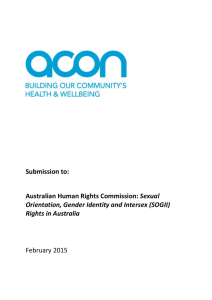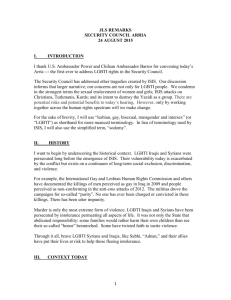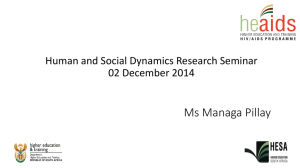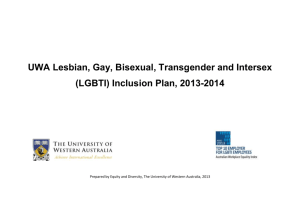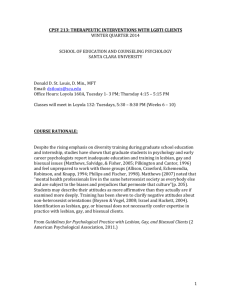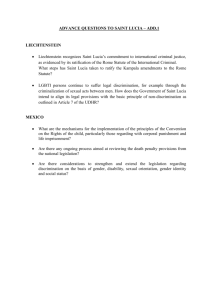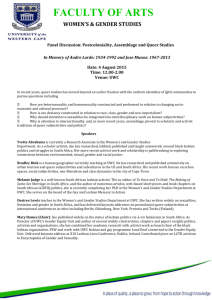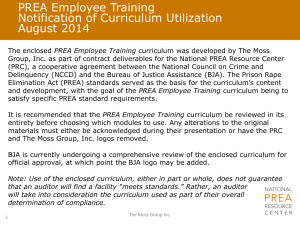Submission to - Mental Health Commission of NSW
advertisement
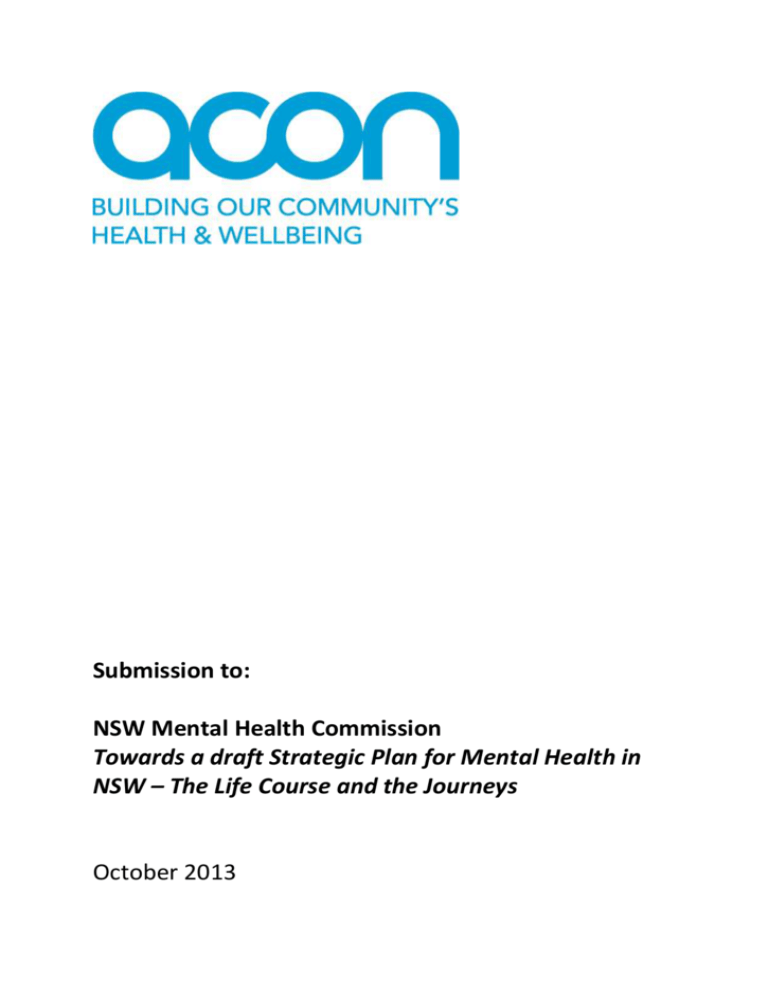
Submission to: NSW Mental Health Commission Towards a draft Strategic Plan for Mental Health in NSW – The Life Course and the Journeys October 2013 About ACON ACON is New South Wales’ leading health promotion organisation specialising in HIV and LGBTI health. Incorporated in 1985 as the AIDS Council of NSW, ACON has been widely recognised as an innovative, successful organisation which has adapted to changes in the HIV epidemic and responded early to emerging health issues among our communities. ACON has been at the forefront of advocacy around issues relating to HIV and to LGBTI health, drawing on our close connections to community to identify emerging issues and create dialogue around these issues with policy makers and researchers. ACON has also worked alongside researchers and partners to build a stronger evidence base around HIV and gay men’s sexual behaviour and LGBTI health, much of which has subsequently affirmed the issues identified by our communities. ACON has an ongoing commitment to improve the mental health and wellbeing of our communities, as evidenced by the commitments made in our Mental Health Strategy 2010 – 2013 and our current Strategic Plan 2013 - 2018. We have, over a long period of time, undertaken advocacy work to address the social determinants of mental health, including in the areas of discrimination, school environments and homophobic violence. We have also addressed mental health concerns directly in advocacy around health strategies and alcohol and other drug treatments. We have projects that address the impacts of alcohol and drug use, counselling and social work supports and housing supports. More recently we have undertaken specific projects, such as the Peace of Mind Project that directly addressed the mental health literacy of our communities and the capacity of service providers to offer inclusive services. General Comments ACON welcomes the production of the working paper ‘Towards a draft Strategic Plan for Mental Health in NSW – The Life Course and the Journeys’ and the opportunity to comment on it. We think that it is an excellent piece of work that will assist in the improvement of the mental health response in NSW. ACON believes that a whole of government approach is required to address the full range of issues posed by mental health across the population, including the issues for LGBTI people. We appreciate and acknowledge the recognition of LGBTI people as a distinct population with specific needs, however we believe more is needed than inclusion in a catch all reference to diversity. It is important for the strategic plan to articulate in more detail how LGBTI issues can be embedded across the strategy, including how to achieve the desired outcomes. While a separate strategy might not be required, a sub-strategy or action plan will be required to measure outcomes and to ensure accountability. We understand that the NSW Government is in a tight budgetary position. In our submission we have therefore paid particular attention to activities that will have a high impact with minimal cost. While accepting that this is the case currently, ACON would like to see incremental increases in the budget to address mental health across the state. Looking to the future we would like to see a significant increase in funding such as that previously seen under the state disability plan ‘Stronger Together: A new direction for disability services in NSW 2006-2016’. The Current system The response to mental health in NSW has a number of strengths, but we agree with the NSW Government and the NSW Mental Health Commission (NMHC) that the mental health system is characterised by under investment, with the rate of expenditure on mental health and related services disproportionate to the burden of morbidity from mental ill health. The response to mental health in NSW is also characterised by discontinuity of service and this is coupled with a greater reliance on institutionalisation than in other states of Australia. ACON is also concerned that there has been a significant under-resourcing of community mental health services in NSW. This has led to the reliance on institutional models of care. It is likely to have limited the ability of the community mental health sectors responses to be flexible and responsive to individuals’ needs. Addressing these issues will be important to improving mental health in NSW. We note that this has been recognised, as shown by the establishment of the NMHC and policies to guide its work. This is an important step on the journey to creating a system that appropriately responds to the mental health needs of the NSW population. The response to mental health in NSW has a number of strengths. NSW has seen a positive engagement with the recovery based approach to mental health. This approach has not been taken on sector wide, but there have been pockets of excellence and the community mental health sector has been engaging in discussions on its usefulness and on implementation. NSW has also made some strides to recognising the close relationship of mental health and alcohol and other drug issues. There have been attempts to integrate the approaches to both of these areas and this has led to positive outcomes for some people. The Future Mental Health System ACON believes that a less institutional system that invests in prevention, mental health literacy and greater integration between all levels of support, is required. This will require greater involvement and connectedness between the community mental health services, clinical services and greater involvement of community, friends, and chosen support networks. Clearer recognition of LGBTI people as a priority population group is required to ensure that the health disparities that exist between our communities and the broader population are addressed. A growing body of evidence from overseas and Australia reveals significant disparities in the mental health status of LGBTI communities and individuals relative to either general community or heterosexually identifying samples. There is not the space here to enumerate all of these here, but among the most significant are: Higher rates of anxiety and depression among gay men, lesbians, bisexuals and transgender people (Ritter et el 2012, Hillier et al 2008, Carman et al 2012, Leonard et al 2012, Couch et al 2007) Higher rates of attempted suicide, suicidal ideation and self-harm, especially among younger people (Hillier et al 2008, Hillier et al 2010) Higher rates of suicidal ideation among GLBT adults than in equivalent studies of heterosexual adults (Suicide Prevention Australia 2012, Ritter et al 2012) We would presume rates of severe mental illness to be no different to the general population. There is however little data on rates of severe mental illness in our communities, a consequence of the lack of inclusion of sexuality indicators in much research and service provider/health care data sets. Research indicates that there are higher rates of drug and alcohol use and dependence in LGBTI communities, which may influence the rates of severe mental health issues amongst our communities We see two broad areas of action, which are low cost and high impact, and could have a significant impact on these issues. We understand that there is no growth money associated with the development of the NMHC Strategic Plan and therefore believe that these low cost - high impact activities should be prioritised until the budgetary situation improves. The first is that mental health services broadly need to be accessible and appropriate to LGBTI people. This can be achieved through capacity development work similar to that which we undertook through the Peace of Mind Project and the National LGBTI Health Alliance’s Mind Out program. The Peace of Mind Project sought to give LGBTI community members the skills to help each other and also ran a series of workshops targeting community members and mainstream service providers. These service provider workshops will continue to be offered in partnership with Gay and Lesbian Health Victoria. The second area is undertaking specific actions to address the significantly higher rates of suicidality (including attempted suicide), anxiety and depression that are seen in our communities. These include continued advocacy around discrimination, schools curricula and homophobic violence, along with increasing the mental health literacy of our communities and working in partnership with the mental health sector to develop appropriate interventions and services to prevent or address mental ill health and promote mental wellbeing. The issues affecting LGBTI populations and their solutions should be embedded across this strategic plan, and in our view can be achieved with minimal additional investment. In order to address the mental health needs of the LGBTI population, ACON suggests that the strategic plan incorporate the following five broad strategies: 1) Ensuring a mental health workforce that is inclusive of LGBTI consumers Appropriate mental health care and promotion for LGBTI populations can be delivered at a low cost by the ongoing development of a culturally competent workforce. This can be attained through inclusivity training and the promotion of consumer-centred care which is non-judgmental and holistic. A systematic approach to the education and training of a LGBTI inclusive health care workforce is needed. The introduction of a LGBTI inclusivity module for all health care professionals in training, delivered in collaboration with the LGBTI community, may be a first step. 2) Early intervention for LGBTI youth Mental health issues are found in greater prevalence amongst LGBTI populations compared to the general population. In particular, the research suggests that younger LGBTI people are at an increased risk of depression, anxiety disorders, self-harm and suicide due to their experiences of heterosexist discrimination and abuse (Cochran et al, 2003; Cochran & Mays, 2009; Sandfort et al, 2001; Brennan et al, 2010; King et al, 2008). In order to begin to reduce this inequity early intervention programs must be actively inclusive of LGBTI youth. Innovative and meaningful interventions must be developed that are attractive to youth but that also respect their journeys of self-discovery and identity formation. 3) Inclusion of LGBTI populations within broader mental health promotion and mental health literacy campaigns A potentially cost effective way of building mental health literacy among LGBTI populations is the inclusion of LGBTI specific issues and imagery in larger public health and community erected campaigns. This will not only continue to normalise LGBTI populations in society but also draw attention to unique community needs. These campaigns will also have greater impact if tailored marketing and communication strategies along with distinct execution to effectively reach LGBTI populations are offered. 4) Specialist mental health and D&A services for LGBTI populations where necessary The development of specialist mental health and D&A services for LGBTI populations may be necessary in some cases, as an adjunct to inclusive generalist services. Research shows that inclusive generalist services are acceptable for many issues, but that some LGBTI people and sub populations require or strongly prefer specific interventions. This is especially the case where the resultant behaviours and challenges involve direct discussion of sexuality and sexual behaviours. Implementation-based research could provide an innovative way to develop new models that effectively address mental health and D&A issues for LGBTI communities. 5) Addressing the structural and social determinants of the mental health disparities found amongst LGBTI populations, utilising a whole of government approach In order to ensure a safe and healthy environment for LGBTI populations, we must continue to partner with the all sectors of government to promote inclusive environments. A whole of government approach to mental health promotion is necessary to best address not only the needs of LGBTI populations but all groups in NSW. There is also a need for better data collection of LGBTI indicators in mainstream research and service provision as this will help to better identify who is at risk of poorer outcomes, patterns of service provision potentially effective interventions. Similar work is being undertaken by other government agencies including the NSW Ministry of Health and the Australian Government Department of Health and Department of Social Services. The life course model that the draft strategic plan presents is a useful and comprehensive way to view mental health across time and place. We would like to provide the Commission with feedback on how the life course model can be applied to LGBTI populations. Please refer to Appendix A for a description of LGBTI-specific concerns along the life course and interventions that could begin to address these concerns. Conclusion ACON looks forward to fulfilling our role in improving the mental health of the LGBTI communities we serve. We will continue to engage in advocacy for our communities, including focusing on antidiscrimination protections, anti-violence work, the Proud Schools program, sector capacity development, the Pride in Diversity workplace inclusion program and making policy submissions to relevant inquiries. Improved services are necessary to meet the needs of LGBTI populations. ACON is committed to working in partnership with the mental health sector to provide our communities with better mental health awareness, mental health literacy and with effective health promotion and prevention campaigns. ACON currently has no dedicated ongoing mental health funding, however we believe we can achieve this work with only a modest investment from the state government. We are committed to working in partnership to address our communities’ needs and look forward to future collaboration with the commission and relevant government agencies and Ministries to ensure we are able to address the mental health outcome disparities seen across the LGBTI population. Appendix A LIFE COURSE MODEL The life course model that the draft strategic plan presents is a useful and comprehensive way to view mental health across time and place. We would like to provide the commission with feedback on how the life course model can be applied to LGBTI populations. The following section will describe LGBTI-specific concerns along the life course and interventions that could begin to address these concerns. 1) Building community resilience and wellbeing A growing body of evidence from overseas and Australia reveals significant disparities in the mental health status of LGBTI communities and individuals relative to either general community or heterosexually identifying samples. There is growing agreement among both researchers and community that the mental health disparities seen among LGBTI communities are in large part a consequence of homophobic/heterosexist or transphobic/cisgenderist discourses and their cultural consequences, noting the still high rates of verbal and physical abuse directed at our communities. Fear of discrimination remains a powerful associate of anxiety across the age spectrum. Other factors associated with higher risk of depression for non-heterosexual populations have been identified as residential context (those living in rural, regional or outer metropolitan areas) victimisation (verbal, sexual or physical) and experiences of stigma and discrimination. That said, the majority of LGBTI lead happy, healthy and productive lives, and an understanding of the factors that contribute to resilience is important to identifying strategies to address these disparities. They note Australian research which has found a positive impact arising from a sense of belonging to gay communities (McLaren et al 2007). Carman and co-authors identify being in a relationship and a sense of belonging to GLB community as protective factors from depression for non-heterosexual populations (Carman et al 2011). US studies of resilience among transgender youth and people of colour have identified common ‘resilience themes’ including self-worth and self-esteem, awareness of oppression, connection with community and a sense of personal mastery.(Singh et al 2009, Singh and McKleroy 2011,Grossman et al 2011). These individual factors of resilience are influenced heavily by environments and the extent of social inclusion. For instance, a recent study from Massachusetts (Hatzenbuehler et al 2012) shows a marked impact of marriage equality on the mental health and wellbeing of LGBTI people. In this study mental health service use among gay men and the attendant costs had declined in the two years since same sex marriage was legalised, regardless of whether men intended to marry or not. A study from California found significantly less distress among same sex married partners compared to those with no formal legal recognition of their relationships (Wight et al 2013). Both of these studies suggest that the mental health dividends from acts of social inclusion such as marriage equality can be significant. ACON has therefore worked consistently to address these social determinants by, for instance, advocating for better schools education around homophobia and bullying, addressing violence and abuse through anti violence campaigns and services, and to build resilience through implementing programs to support community attachment. More recently, through our Peace of Mind program, we have implemented a series of workshops intended to help community members identify and respond to mental distress among their peers, family or friendship networks. These workshops demonstrated good outcomes for those who attended – however it is our observation that most of those who attended had a high level of personal investment in mental health issues as a result of their own or a loved one’s mental health experiences. Raising broader LGBTI community awareness of mental health issues is therefore a critical issue in building community resilience and wellbeing. Rather than developing specific LGBTI awareness campaigns, we believe that LGBTI specific executions of broader mental health awareness campaigns, together with targeted marketing strategies in relevant media, would be a cost effective way of increasing mental health literacy across the LGBTI community and encouraging uptake of mental health awareness workshops and online interventions. The LGBTI community also has extensive experience with stigma and discrimination, primarily in relation to sexual orientation, gender identity and HIV-related stigma. Much resilience has been built in combating these forces. The lessons learnt can be used to inform the fight against mental health stigma. 2) The best start The limited research to date on the health and learning outcomes of children in same sex parenting arrangements indicate that they do no worse than those with mixed sex parents. Herek (2006) indicates that LGBTI and heterosexual relationships do not differ in their essential psychosocial dimension; that a parent’s sexual orientation is unrelated to her/his ability to provide a healthy and nurturing family environment. However, sustaining these outcomes requires some effort on the part of the mental health system and society more broadly. LGBTI parents experience many challenges that are unique and can impact on their mental health and their children’s mental health. The stigma and discrimination often experienced by LGBTI people adds to the already stressful experience of becoming a new parent. Additionally, many LGBTI people experience social isolation and often do not have the family support that other groups may have. The disparities experienced in reproductive rights and the practical considerations of surrogacy and adoption can also strongly impact anxiety levels and mood. Lesbian and bisexual women have also been shown to experience post-partum depression at higher rates than their heterosexual counterparts (Ross et al 2007). The barriers and stressors that impact the mental health of LGBTI families can be addressed in simple and cost effective ways. The creation and coordination of social support networks for LGBTI parents is a critical way that the community can support itself and that parents can learn from each other. The creation of these support networks can arise from existing community mental health programs or can be facilitated by the community itself. Furthermore, to address the mental health issues of LGBTI populations, a clinical nurse consultant could be dedicated to caring for LGBTI parents across the state, with a focus on post-partum depression among lesbians. 3) Troubled kids Although many gay and lesbian adults may not be aware of their sexual orientation during childhood, transgender and intersex adults are often very aware at an early age that their assigned gender or sex does not match their own understanding of their gender or sex. Children who are gender questioning or who manifest gender non-conforming behaviour appear to be at a higher risk of developing mental health issues later in life (Bartlett et al. 2000). This depends however on how these issues are handled by parents and other caregivers. Many parents of children who are gender questioning experience stigma and battle with feelings of shame. Awareness of how to appropriately respond to these issues must be promoted for these children to have the opportunity to develop in ways that match their understandings of gender and sex. In order to accomplish this, the education sector must be incorporated into the solution. Inclusivity training could be a way forward; teachers must be aware of these issues and work together with parents and health professionals to understand the experiences of gender questioning and intersex children. 4) Healthy transitions Youth and young adulthood is a critical stage of the life course for the prevention and early intervention of mental health issues. This stage is especially important for LGBTI youth as they experience a higher prevalence of anxiety disorders, depression and suicide than their peers in the general population (Cochran et al, 2003; Cochran & Mays, 2009; Sandfort et al, 2001; Brennan et al, 2010; King et al, 2008). It is at this stage that many LGBTI youth come to terms with their sexual orientation and gender identities. As a consequence of their quest for self-identity, many LGBTI youth are subjected to experiences of violence and homophobia which can very negatively impact on their mental health (Hillier et al. 2010). It is critical that we support and care for these youth at this most vulnerable time. Many LGBTI people migrate to urban centres and also loose family support at this time. They often enter workplaces that do not accept them and as a result face increased occupational stress. There are two areas that require specific focus to improve the mental health of LGBTI people at this life stage. First, work must be done with the school system to address bullying and homophobia. Furthermore, in the school setting, we are concerned that the most recent draft National Health and Physical Education curriculum has failed to address sexuality at all and has taken out references to homophobia and transphobia. This leaves school aged Australians poorly equipped to manage their sexual and mental health, and leaves teachers with no basis on which to engage students around issues of sexual diversity, acceptance and inclusion. Secondly, the breakdown in family support that some LGBTI youth face, especially in rural areas, as a result of stigma and the migration of LGBTI people to urban centres needs to be counteracted by the community. We can learn from and build on work that is already occurring to support LGBTI youth at this critical moment in their lives. ACON has run a successful young men’s and women’s program which uses peer facilitators to engage youth in health promoting groups and which also serves to build their social networks. The Inspire Foundation and ACON are currently developing an “app”-based decision making tool to help LGBTI youth with coming out and connect them to relevant services and social networks. The Pride in Diversity program at ACON has engaged with employers to create more inclusive workplaces that value diversity and protect LGBTI individuals entering the workforce. ACON has also supported the NSW Proud Schools Program which has promoted LGBTI friendly schools and addressed homophobia and bullying. Continued work must be done with the LGBTI community, the education sector, employers and the general public to ensure that LGBTI youth have safe places to “come out” in (should this be their choice) and to build social capital. These supports for youth are essential in combating the increased rates of mental illness experienced among LGBTI people across the lifespan. 5) Towards a better life There exists a lack of data on the prevalence of adult severe mental health among LGBTI populations; more research is especially needed to understand how bipolar disorder, personality disorders, psychosis and schizophrenia affect these groups. It is known that LGBTI populations experience higher rates of anxiety and depression (Cochran et al, 2003; Cochran & Mays, 2009; Sandfort et al, 2001; Brennan et al, 2010; King et al, 2008); however more research is needed to understand how these groups experience and live with these illnesses over the life course. The increased mental health issues associated with HIV infection also intersect with the broader mental health concerns of these groups, as the majority of people with HIV in NSW are gay men (NSW Ministry of Health, 2013). Interventions that address holistically the complex needs of LGBTI groups are necessary to address both their mental health and sexual health concerns. 6) Breaking the cycle Data from the National Survey of Mental Health and Wellbeing (2007) indicates that drug use was nearly three times more prevalent in homosexual/bisexual populations (15.74%) compared to heterosexual populations (6.88%); drug dependence was found at about double the prevalence in homosexual/bisexual populations (5.65%) compared to heterosexual populations (2.73%). Public health interventions to reduce problematic drug use are essential to improving both the mental and sexual health of LGBTI populations in NSW. A focus on alcohol is also necessary as it continues to be widely misused and has serious physical health implications, both for LGBTI populations and the general public. ACON strongly supports keeping people with drug and alcohol issues out of the justice system and strongly believes that the decriminalisation of drug use will lead to more openness and capacity to refer consumers to appropriate services; as evidenced in the success of drug decriminalization in countries such as the Netherlands and Portugal. ACON offers a specialist drug and alcohol counselling service and a social work service which have had success in helping people to break the cycle of drug use and mental health issues. We believe that there is a need for a specialist drug service in addition to the broader inclusion of LGBTI concerns in the health system. Implementation-based research could provide an innovative way to develop new models that address mental health and D&A issues for LGBTI communities. ACON and a research partner could collaborate and trial a LGBTI specific mental health service that could be housed at ACON. The research could provide useful information about what worked well, suggestions for improvement and a richer understanding of the population and the providers experience throughout the process. 7) Body and soul In general, despite the increased rates of mental health issues, the physical health of LGBTI populations appears (while also recognising the absence of these communities from many large scale public health research programs) much the same as the general population. However, gay men in particular face higher rates of STIs and HIV which themselves lead to an increased risk for physical and mental health problems (NSW Ministry of Health, 2013). Also, recent data indicates that older LGBTI populations do experience higher rates of certain types of cancer, mental health concerns and also obesity (Byles, 2013). These increased rates of physical health issues impact the mental health of LGBTI populations. ACON is addressing these issues through its current HIV/sexual health and healthy aging programs. 8) Living long and strong The increased rates of depression and anxiety found in LGBTI populations continue into older age (Byles, 2013). The processes of social isolation and exclusion often have cumulative effects and leave older LGBTI people with fragmented support networks. It is essential that we build an awareness of the special needs of LGBTI elders and that we work in partnership with a range of stakeholders to provide these people with opportunities to contribute to society and be social. Ongoing advocacy is also needed to ensure that LGBTI people are treated respectfully at aged care facilities. Inclusivity training for aged care providers is an area that ACON has begun working in, through rolling out a workforce development across NSW. In this work, ACON has been greatly supported by the inclusion of reference to GLBT populations in the NSW Government’s Healthy Ageing Strategy and by the Commonwealth Government’s efforts in implementing a dedicated National Lesbian, Gay, Bisexual, Transgender and Intersex (LGBTI) Ageing and Aged Care Strategy. We would be pleased to be able to add the NSW Mental Health Strategy to this list of enabling policy frameworks. Bibliography Bartlett, N., Vasey, P., Bukowski, W. (2000) Is Gender Identity Disorder in Children a Mental Disorder? Sex Roles, 753. Brennan, D., Ross, L., Dobinson, C., Veldhuizen, S., & Steele, L. (2010). Men's Sexual Orientation and Health in Canada. Canadian Journal of Public Health, 255-258. Byles, J. (2013). Factors Influencing Health for the Older LGBTI Person: A SEEF Perspective. Presentation: University of Newcastle. Carman, Marina, Julienne Corboz, Gary W. Dowsett Falling through the cracks: the gap between evidence and policy in responding to depression in gay, lesbian and other homosexually active people in Australia Australian And New Zealand Journal Of Public Health 2012 vol. 36 no. 1 Cochran, S., & Mays, V. (2009). Burden of psychiatric morbidity among lesbians, gay and bisexual individuals in the California Quality of Life Survey. Journal of Abnormal Psychology, 647-658. Cochran, S., Sullivan, G., & Mays, V. (2003). Prevalence of Mental Disorders, Psychological Distress and Mental Health Services Use Among Lesbian, Gay and Bisexual Adults in the United States. Journal of Consulting and Clinical Psychology, 53-61. Couch M, Pitts M, Mulcare H, Croy S, Mitchell A, Patel S, 2007, Tranznation, A report on the health and wellbeing of transgender people in Australia and New Zealand. Australian Research Centre in Sex, Health and Society, LA Trobe University, Melbourne Grossman, A. H., D'Augelli, A. R., & Frank, J. A. 2011. Aspects of psychological resilience among transgender youth. Journal of LGBT Youth,8(2), 103-115. Herek, G. M. (2006). Legal recognition of same-sex relationships in the united states: A social science perspective. American Psychologist, 61(6), 607-621. Hillier, Lynn, Jane Edwards & Damien W. Riggs 2008 Guest Editorial: Mental Health And LGBT Communities Gay & Lesbian Issues and Psychology Review, Vol. 4, No. 2 Hillier, L., Jones, T., Monagle, M., Overton, N., Gahan, L., Blackman, J. & Mitchell, A. (2010) Writing Themselves in 3: The third national study on the sexual health and wellbeing of same sex attracted and gender questioning young people. Monograph Series Number 78. Melbourne: The Australian Research Centre in Sex, Health & Society, La Trobe University. King, M., Semlyen, J., See Yai, S., Killaspy, H., Osborn, D., Popelyuk, D., & Nazareth, I. (2008). A systematic review of mental disorder, suicide, and deliberate self harm in lesbian, gay and bisexual people. BMC Psychiatry, 1186-2003. Leonard, William, Marian Pitts, Anne Mitchell, Anthony Lyons, Anthony Smith, Sunil Patel, Murray Couch and Anna Barrett 2012 Private Lives 2: The second national survey of the health and wellbeing of gay, lesbian, bisexual and transgender (GLBT) Australians. Monograph Series Number 86. Melbourne: The Australian Research Centre in Sex, Health & Society, La Trobe University. McLaren, Suzanne; Jude, Belinda; McLachlan, Angus J. 2007 Sexual Orientation, Sense of Belonging and Depression in Australian Men International Journal of Men's Health 6. 3 (Fall 2007): 259272. National Survey of Mental Health and Wellbeing (2007). http://www.health.gov.au/internet/publications/publishing.nsf/Content/drugtreat-pubscomorbid-toc~drugtreat-pubs-comorbid-3~drugtreat-pubs-comorbid-3-3 NSW Ministry of Health (2013) HIV Strategy 2012-2015 – Snapshot June 2013. http://www.health.nsw.gov.au/sexualhealth/Documents/NSWnapshotHIV.pdf Ritter, Alison, Matthew-Simons, Francis, Carragher, N Prevalence of and interventions for mental health problems and alcohol and other drug problems amongst the gay, lesbian, bisexual and transgender community: a review of the literature Drug Policy Modelling Program Monograph no 23, NDARC Dec 2012 Ross, L., Steele, L., Goldfinger, C., & Strike, C. (2007) Perinatal depressive symptomatology among lesbian and bisexual women. Archives of Women’s Mental Health, 53-59. Sandfort, T., De Graaf, R., Bijl, R., & Schnabel, P. (2001). Same-sex sexual behavior and Psychiatric Disorders. Archives of General Psychiatry, 85-91. Singh, Anneliese A, McKleroy, Vel S. ''Just Getting Out of Bed Is a Revolutionary Act'' : The Resilience of Transgender People of Color Who Have Survived Traumatic Life Events Traumatology 2011 17: 34 originally published online 7 May 2010 Singh, Anneliese A;Hays, Danica G;Watson, Laurel S Strength in the Face of Adversity: Resilience Strategies of Transgender Individuals Journal of Counseling and Development : JCD; Winter 2011; 89, 1; Suicide Prevention Australia 2009 Position Statement – Suicide and self-harm among Gay, Lesbian,Bisexual and Transgender communities– June 2009 http://suicidepreventionaust.org/wp-content/uploads/2012/01/SPA-GayLesbianPositionStatement.pdf
